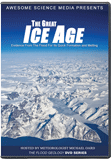Hotting Up For an Ice Age
Originally published in Creation 16, no 3 (June 1994): 22-23.
Ask just about anyone, ‘Was the Ice Age caused by things getting colder or warmer?’ They will almost certainly say, ‘That’s obvious. Colder, of course!’
Ask just about anyone, ‘Was the Ice Age caused by things getting colder or warmer?’ They will almost certainly say, ‘That’s obvious. Colder, of course!’
They may suggest that volcanic eruptions blocked out sunlight, or the sun went through a period of weaker radiation. This increase in ‘coldness’, it is believed, was the reason why millions of cubic kilometres of ice previously covered a lot of the dry land in the northern and southern parts of the globe.
The idea of an Ice Age (or Ages) was first mooted last century, and was rapidly accepted. The massive blankets of lime, gravel and sand in northern Europe, for example, are easily explained that way. Nowadays, mountain glaciers transport and deposit such materials in a similar way, albeit on a smaller scale.
In classical ‘historical’ geology, there were a number of periods of ice formation, but the one containing really convincing evidence is the so-called ‘Pleistocene’. There are supposed to have been advances and retreats of the ice sheet during many thousands of years, with the last of these ending about 10,000 years ago.
Creation scientists note that evidence for this ice is generally located on top of Flood deposits, and so they believe the Ice Age happened after the Flood. We will see that the Ice Age must have happened quickly, and that it could not have been caused by things getting colder, but (against all intuition) the very opposite.
An important clue is that the ice sheet covered the dry land above sea level, so the water for this ice must have come from above (as snow). However, the atmosphere contains only as much water as has evaporated from the surface of the oceans. The evaporation of water from the oceans is in balance with the amount later deposited out of the atmosphere. The more that evaporates, the more that falls as rain, hail or snow.
If there is a higher input of energy to the oceans, the amount which is ‘turned over’ in this way increases. Conversely, less energy means less turnover. This means that the earth could not have become progressively colder—this would not have allowed millions of cubic kilometres of additional water to leave the oceans and end up on the land. So the popular explanation for the cause of the Ice Age—that the world somehow became colder—would appear to be incorrect.
It is also very unlikely that the Ice Age glaciers formed from slowly accumulating snow. In the depths of a cold winter, the colder it gets, the less it snows (because cold air can hold less moisture). The largest amounts of ice, even if only over a limited area, don’t fall from the sky in winter, but as hail in summer. Hail results when moist warm air rapidly rises to great heights, where the temperatures are below freezing. The little nuclei of ice, as they fall, grow larger.
So, unless there is an increase in warmth, there will never be enough extra water extracted from the oceans to generate the large ice sheets. There must have been a source of energy to evaporate masses of water from the oceans and redeposit them on land as ice.
Such warming has to happen quickly, so that the evaporation (and precipitation as ice/snow) at the beginning of the Ice Age happens more rapidly than the tendency of the ice on land to melt again. So it seems certain that the glacial ice sheets must have been laid down rather quickly, not over thousands of years as is widely taught.
Such an imbalance in the climatic economy of our earth must logically have had catastrophic causes. In the biblical Flood model, there are ample reasons for an increase in available energy. Warmer oceans would have resulted from the addition of warmer subterranean water which had been in the ‘fountains of the great deep’, as well as associated volcanic activity. Rapid continental break-up during (and perhaps continuing to some extent after) the Flood is increasingly becoming a part of creationist geological models. This break-up, too, involves large amounts of energy released as heat.
A ‘slow and gradual’ evolutionary Ice Age would appear to be physically impossible. Nevertheless, such a theory is almost universally held and taught, because the alternative would lead directly to the short time-frame of biblical earth history.
Recommended Resources

Answers in Genesis is an apologetics ministry, dedicated to helping Christians defend their faith and proclaim the good news of Jesus Christ.
- Customer Service 800.778.3390
- © 2025 Answers in Genesis




